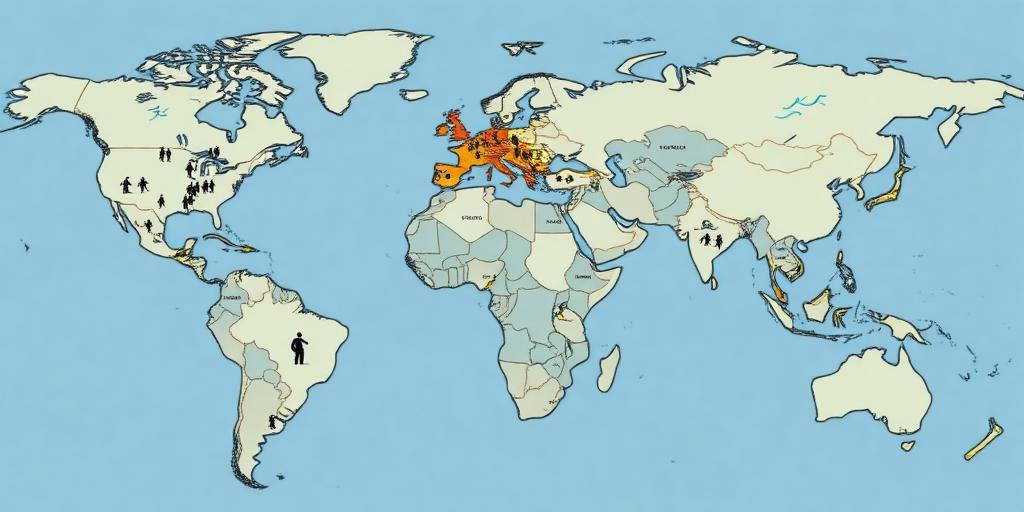The Intersection of Climate Change and Migration at Borders
Climate change is no longer a distant threat; it is a present reality reshaping our world. One of the most profound consequences of this environmental crisis is its impact on human migration, particularly at international borders. This article explores the intricate relationship between climate change and migration, examining how environmental stressors are driving displacement and creating new challenges for border management and humanitarian efforts.
Climate Change as a Driver of Migration
Climate change acts as a threat multiplier, exacerbating existing social, economic, and political vulnerabilities. Its effects—such as rising sea levels, extreme weather events, desertification, and resource scarcity—directly impact people's livelihoods and safety, forcing them to move. These environmentally induced migrations are increasingly recognized as a significant aspect of global migration patterns.
- Environmental Degradation: Desertification and soil erosion reduce agricultural productivity, leading to food insecurity and displacement, especially in regions dependent on agriculture.
- Extreme Weather Events: Hurricanes, floods, and droughts can destroy homes and infrastructure, making areas uninhabitable and prompting mass movements of people.
- Sea Level Rise: Coastal communities face inundation and erosion, forcing relocation and posing existential threats to low-lying island nations.
- Resource Scarcity: Water and food shortages, intensified by climate change, can lead to conflicts and displacement, as communities compete for dwindling resources.
Migration Patterns and Border Management
The convergence of climate-induced migration and border management presents complex challenges. Traditional border control measures are often ill-equipped to handle the influx of climate migrants, who may not fit the legal definition of refugees under international law. This gap creates protection challenges and necessitates a re-evaluation of border policies.
- Increased Border Pressures: Climate-induced migration can strain border resources and infrastructure, leading to humanitarian crises and security concerns.
- Legal and Protection Gaps: Climate migrants often fall outside the scope of refugee protection, leaving them vulnerable to exploitation and refoulement.
- Policy and Governance Challenges: Governments must develop comprehensive policies that address the needs of climate migrants while respecting their rights and dignity.
Case Studies: Climate Change and Migration
Several regions around the world are already experiencing the impacts of climate change on migration patterns. These case studies illustrate the diverse ways in which environmental factors are driving displacement and shaping border dynamics.
- The Sahel Region: Prolonged droughts and desertification have led to widespread food insecurity and displacement, with many people migrating to urban areas or neighboring countries in search of livelihoods.
- Bangladesh: Rising sea levels and frequent cyclones have displaced millions of people in the coastal regions, forcing them to migrate to already overcrowded cities or across borders.
- Central America: Climate change-induced crop failures and extreme weather events have contributed to increased migration from rural areas to urban centers and towards the United States.
Addressing the Challenges
Addressing the intersection of climate change and migration at borders requires a multifaceted approach that integrates climate action, migration management, and humanitarian assistance. Key strategies include:
- Mitigation and Adaptation: Reducing greenhouse gas emissions and implementing adaptation measures to build resilience in vulnerable communities.
- Policy and Legal Frameworks: Developing legal frameworks that recognize and protect the rights of climate migrants, ensuring access to essential services and durable solutions.
- International Cooperation: Strengthening international cooperation and burden-sharing to address the cross-border dimensions of climate-induced migration.
- Humanitarian Assistance: Providing humanitarian assistance to climate migrants, including shelter, food, water, and healthcare, while upholding their dignity and rights.
Conclusion
The intersection of climate change and migration at borders represents one of the most pressing challenges of our time. As environmental stressors intensify, displacement will likely increase, placing additional strain on border management systems and humanitarian resources. By adopting a comprehensive and collaborative approach, we can mitigate the impacts of climate change on migration, protect the rights of those displaced, and build a more sustainable and equitable future for all.









